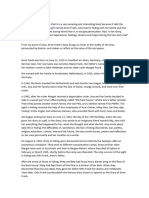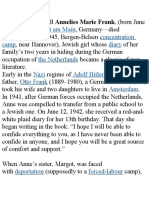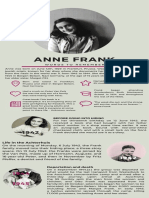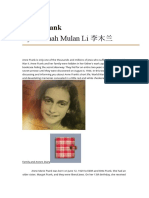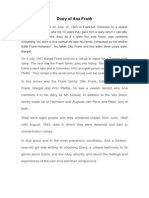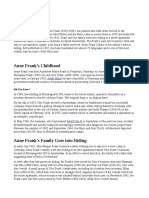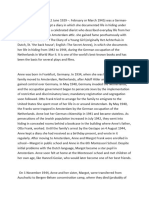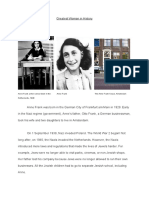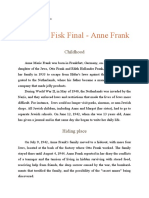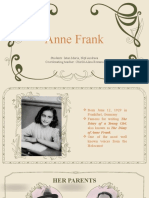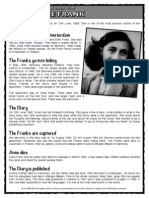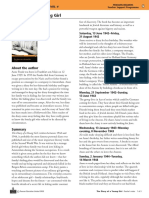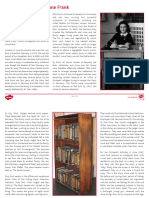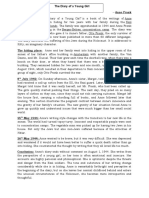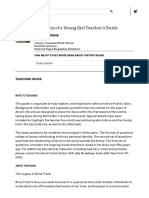Professional Documents
Culture Documents
Biography of Anne Frank
Biography of Anne Frank
Uploaded by
KOMBAN GAMING0 ratings0% found this document useful (0 votes)
76 views1 pageDecathlon is offering free delivery in India from August 12-15th to celebrate Indian Independence Day. Anne Frank was a German-born diarist and writer who is known for her diary chronicling her family's time in hiding during the Nazi occupation of the Netherlands in World War II. She was born in Frankfurt in 1929 and lived in Amsterdam until going into hiding in 1942 at age 13, where she wrote in her diary until being discovered and arrested in 1944. She died at the Bergen-Belsen concentration camp at age 15, shortly before it was liberated. Her diary was published after the war and has become one of the most widely read books in the world.
Original Description:
Original Title
BBFF3AB1-A62B-4C7F-B8C7-BA19139406AE
Copyright
© © All Rights Reserved
Available Formats
PDF, TXT or read online from Scribd
Share this document
Did you find this document useful?
Is this content inappropriate?
Report this DocumentDecathlon is offering free delivery in India from August 12-15th to celebrate Indian Independence Day. Anne Frank was a German-born diarist and writer who is known for her diary chronicling her family's time in hiding during the Nazi occupation of the Netherlands in World War II. She was born in Frankfurt in 1929 and lived in Amsterdam until going into hiding in 1942 at age 13, where she wrote in her diary until being discovered and arrested in 1944. She died at the Bergen-Belsen concentration camp at age 15, shortly before it was liberated. Her diary was published after the war and has become one of the most widely read books in the world.
Copyright:
© All Rights Reserved
Available Formats
Download as PDF, TXT or read online from Scribd
Download as pdf or txt
0 ratings0% found this document useful (0 votes)
76 views1 pageBiography of Anne Frank
Biography of Anne Frank
Uploaded by
KOMBAN GAMINGDecathlon is offering free delivery in India from August 12-15th to celebrate Indian Independence Day. Anne Frank was a German-born diarist and writer who is known for her diary chronicling her family's time in hiding during the Nazi occupation of the Netherlands in World War II. She was born in Frankfurt in 1929 and lived in Amsterdam until going into hiding in 1942 at age 13, where she wrote in her diary until being discovered and arrested in 1944. She died at the Bergen-Belsen concentration camp at age 15, shortly before it was liberated. Her diary was published after the war and has become one of the most widely read books in the world.
Copyright:
© All Rights Reserved
Available Formats
Download as PDF, TXT or read online from Scribd
Download as pdf or txt
You are on page 1of 1
Decathlon Free Delivery Offer
Decathlon 75th Indian Independence Day Free Delivery from
12th to 15th August.
Decathlon India Shop Now
ASSINMENT
POINT
Home Arts Biography Biography of Anne Frank
Biography of Anne Frank
Biography
Anne Frank – Writer (1929-1945)
Full Name: Annelies Marie Frank
Date of Birth: 12 June 1929
Place of Birth: Frankfurt, Germany
Date of Death: February or March 1945
(aged 15)
Place of Death: Bergen-Belsen
concentration camp, Lower Saxony,
Germany
Occupation: Diarist, Writer
Language: Dutch
Nationality: German until 1941
Stateless from 1941
Early Life
Annelies Marie Frank was born on 12 June
1929, in Frankfurt, Germany. She was a
German-born diarist and writer.
For people all over the world, Anne Frank,
the vivacious, intelligent Jewish girl with a
crooked smile and huge dark eyes, has
become the “human face of the Holocaust.”
Her diary of twenty-five months in hiding, a
precious record of her struggle to keep hope
alive through the darkest days of this
century, has touched the hearts of millions.
Anne Frank lived in Amsterdam with her
family during World War II. Fleeing Nazi
persecution of Jews, the family went into
hiding for two years; during this time, Frank
wrote about her experiences and wishes.
She was 15 when the family was found and
sent to the camps, where she died.
One of the most discussed Jewish victims of
the Holocaust, she gained fame
posthumously following the publication of
her diary, The Diary of a Young Girl
(originally Het Achterhuis; English: The
Secret Annex), which documents her life in
hiding from 1942 to 1944, during the
German occupation of the Netherlands in
World War II. It is one of the world’s most
widely known books and has been the basis
for several plays and films.
By May 1940, the Franks were trapped in
Amsterdam by the German occupation of
the Netherlands. As persecutions of the
Jewish population increased in July 1942,
the family went into hiding in some
concealed rooms behind a bookcase in the
building where Anne’s father worked. From
then until the family’s arrest by the Gestapo
in August 1944, Anne kept a diary she had
received as a birthday present, and wrote in
it regularly. Following their arrest, the Franks
were transported to concentration camps. In
October or November 1944, Anne and her
sister, Margot, were transferred to Bergen-
Belsen concentration camp from Auschwitz,
where they died (probably of typhus) a few
months later. They were originally estimated
by the Red Cross to have died in March,
with Dutch authorities setting 31 March as
their official date of death, but research by
the Anne Frank House in 2015 suggests
they more likely died in February.
Frank’s father, Otto, the only survivor of the
family, returned to Amsterdam after the war
to find that her diary had been saved by one
of the helpers, Miep Gies, and his efforts led
to its publication in 1947. It was translated
from its original Dutch version and first
published in English in 1952 as The Diary of
a Young Girl, and has since been translated
into over 60 languages.
Educational and Childhood Career
Frank was born Annelies or Anneliese Marie
Frank on 12 June 1929 at the Maingau Red
Cross Clinic in Frankfurt, Germany, to Edith
and Otto Heinrich Frank. After moving to
Amsterdam, Anne and Margot Frank were
enrolled in school—Margot in public school
and Anne in a Montessori school. Margot
demonstrated ability in arithmetic, and Anne
showed aptitude for reading and writing.
Anne’s friend, Hanneli Goslar, later recalled
that from early childhood, Frank frequently
wrote, although she shielded her work with
her hands and refused to discuss the
content of her writing.
The Frank sisters were excelling in their
studies and had many friends, but with the
introduction of a decree that Jews could
attend only Jewish schools, they were
enrolled at the Jewish Lyceum. Anne
became a friend of Jacqueline van Maarsen
in the Lyceum.
(Anne Frank and Margot Frank)
For her thirteenth birthday on 12 June 1942,
Frank received a book she had shown her
father in a shop window a few days earlier.
In her entry dated 20 June 1942, she lists
many of the restrictions placed upon the
lives of the Dutch Jewish population.
Writing Career
On June 12, 1942, Frank’s parents gave her
a red checkered diary for her 13th birthday.
She wrote her first entry, addressed to an
imaginary friend named Kitty, that same day:
“I hope I will be able to confide everything to
you, as I have never been able to confide in
anyone, and I hope you will be a great
source of comfort and support.”
Weeks later, on July 5, 1942, Margot
received an official summons to report to a
Nazi work camp in Germany. The very next
day, the family went into hiding in makeshift
quarters in an empty space at the back of
Otto Frank’s company building, which they
referred to as the Secret Annex. They were
accompanied in hiding by Otto’s business
partner Hermann van Pels as well as his
wife, Auguste, and son, Peter. Otto’s
employees Kleiman and Kugler, as well as
Jan and Miep Gies and Bep Voskuijl,
provided food and information about the
outside world.
Initially Anne found living in hiding an
adventure and wrote about it excitedly in her
diary. She also developed a romance with
Peter van Pels during this time which she
mentioned in her writings.
Since the family was not allowed to go
outside, she spent most of the time reading
and writing. Her diary became her closest
confidante and she wrote in detail about her
relationships with each of her family
members.
As time wore by, Anne lost her youthful
optimism and began to grow weary of the
confinement. However, she did not lose
hope that life would one day return to normal
and she would go back to school. She
mentioned in her diary that she wanted to be
a writer one day.
To pass the time, Frank wrote extensive
daily entries in her diary. Some betrayed the
depth of despair into which she occasionally
sunk during day after day of confinement.
“I’ve reached the point where I hardly care
whether I live or die,” she wrote on February
3, 1944. “The world will keep on turning
without me, and I can’t do anything to
change events anyway.” However, the act of
writing allowed Frank to maintain her sanity
and her spirits. “When I write, I can shake off
all my cares,” she wrote on April 5, 1944.
The Jewish families were betrayed by an
informer in 1944. Their hiding place was
discovered in August and the Franks, van
Pelses, and Pfeffer were arrested and
interrogated. Having been arrested in hiding,
they were considered criminals.
They were transferred to the Auschwitz
death camp in Poland in the middle of the
night on September 3, 1944. Upon arriving
at Auschwitz, the men and women were
separated. This was the last time that Otto
Frank ever saw his wife or daughters.
After some time, Anne and Margot were
separated from their mother, who later died,
and moved to the Bergen-Belsen
concentration camp where the conditions
were even worse with scarcity of food and
lack of sanitation facilities.
At Bergen-Belsen, food was scarce,
sanitation was awful and disease ran
rampant. Frank and her sister both came
down with typhus in the early spring and
died within a day of each other sometime in
March 1945, only a few weeks before British
soldiers liberated the camp. Anne Frank was
just 15 years old at the time of her death,
one of more than 1 million Jewish children
who died in the Holocaust.
Otto Frank was the only member of his
immediate family to survive. When Otto
returned to Amsterdam, he found Anne’s
diary, which had been saved by Miep Gies.
Otto sought to have selections from his
daughter’s diary published as a book, and
The Secret Annex: Diary Letters from June
14, 1942 to August 1, 1944 was published
on June 25, 1947. “If she had been here,
Anne would have been so proud,” he said.
The Diary of a Young Girl, as it’s typically
called in English, has since been published
in 67 languages.
Frank’s diary is essentially a story of faith,
hope and love in the face of hate. “It’s utterly
impossible for me to build my life on a
foundation of chaos, suffering and death,”
she wrote on July 15, 1944. “I see the world
being slowly transformed into a wilderness; I
hear the approaching thunder that, one day,
will destroy us too. I feel the suffering of
millions. And yet, when I look up at the sky, I
somehow feel that everything will change for
the better, that this cruelty too shall end, that
peace and tranquility will return once more.”
Personal Life
Frank was born Annelies or Anneliese Marie
Frank on 12 June 1929 at the Maingau Red
Cross Clinic in Frankfurt, Germany, to Edith
and Otto Heinrich Frank. She had an older
sister, Margot. The Franks were liberal Jews,
and did not observe all of the customs and
traditions of Judaism. They lived in an
assimilated community of Jewish and non-
Jewish citizens of various religions.
At the time of Anne’s birth the family lived in
a house at Marbachweg 307, where they
rented two floors. In 1931 the family moved
to Ganghoferstrasse 24 in a fashionable
liberal area called the Dichterviertel (Poets’
Quarter). Both houses still exist.
In 1933, after Adolf Hitler’s Nazi Party won
the federal election, Edith Frank and the
children went to stay with Edith’s mother,
Rosa, in Aachen.
By February 1934, Edith and the children
had joined him (Otto) in Amsterdam.
Born in Frankfurt, Germany, she lived most
of her life in or near Amsterdam,
Netherlands, having moved there with her
family at the age of four-and-a-half when the
Nazis gained control over Germany.
Death
At Bergen-Belsen, food was scarce,
sanitation was awful and disease ran
rampant. A typhus epidemic spread through
the camp in 1945 and other diseases like
typhoid fever were also widespread. Though
it is not known what exactly afflicted the
Frank sisters, it is believed that both Margot
and Anne became ill and died sometime in
February or March 1945.
Honours
(Statue of Anne Frank, by Mari
Andriessen, outside the Westerkerk in
Amsterdam)
On 3 May 1957, a group of citizens,
including Otto Frank, established the Anne
Frank Stichting in an effort to rescue the
Prinsengracht building from demolition and
to make it accessible to the public.
In 1997, the Anne Frank Educational Centre
(Jugendbegegnungsstätte Anne Frank) was
opened in the Dornbusch neighbourhood of
Frankfurt, where Frank lived with her family
until 1934. The Centre is “a place where
both young people and adults can learn
about the history of National Socialism and
discuss its relevance to today.”
In 2009, the Anne Frank Center USA
launched a national initiative called the
Sapling Project, planting saplings from a
170-year-old chestnut tree that Anne had
long loved (as denoted in her diary) at 11
different sites nationwide. In more recent
news, the Anne Frank House lost a lawsuit
to the Anne Frank Fonds in June 2013, after
the Fonds sued the House for the return of
documents linked to Anne and Otto Frank.
In November 2007, the Anne Frank tree—by
then infected with a fungal disease affecting
the tree trunk—was scheduled to be cut
down to prevent it from falling on the
surrounding buildings. Dutch economist
Arnold Heertje said about the tree: “This is
not just any tree. The Anne Frank tree is
bound up with the persecution of the Jews.”
YOU MIGHT ALSO LIKE
Biography of Edward Biography of Agatha
Jenner Christie
Biography of Thaddeus Biography of Melvin
Stevens Franklin
Similar Post
Biography of Ralph Vaughan Williams
Biography of Edwin McMillan
Biography of Nicolaus Copernicus
Biography of Mesut Özil
Biography of Haldan Keffer Hartline
Biography of Jonas Salk
Similar Biography Post
Biography of Curly Lambeau
Biography of Stephanie Kwolek
Biography of Robin Gibb
Biography of John Betjeman
Biography of Larry Page
Biography of Jimmy Durante
More Post
CoRoT-7c – an Extrasolar
Planet
Project Hopes To Explain Why
Marsupials Are Better For the Planet
than Other Herbivores
Mehndi Designs for
Wedding
Alunite: Properties and
Occurrence
The HRM Practices in the Event
Management Sector of Bangladesh
Tinnitus
Tinnitus
Latest Post
The Rocky Shells of Water-ice
planets are dissolved by Deep
Oceans
Potassium Deficiency
The Mystery of Pluto’s Surface Ice-
shape Formation has been solved
Early Soil-Surface Ozone Detection
May Reduce Damage to Apples and
➤
Grapes
You might also like
- Anne Frank's Diary - The Graphic - Anne FrankDocument155 pagesAnne Frank's Diary - The Graphic - Anne FrankKishore Kumar100% (4)
- Anne Frank Was A Teenage Jewish Girl Who Kept A Diary While Her Family Was in Hiding From The Nazis During World War IIDocument6 pagesAnne Frank Was A Teenage Jewish Girl Who Kept A Diary While Her Family Was in Hiding From The Nazis During World War IILuz María RamírezNo ratings yet
- The Diary of Anne FrankDocument7 pagesThe Diary of Anne FrankYash MaheshwariNo ratings yet
- Nazi Occupation: Best Known ForDocument2 pagesNazi Occupation: Best Known ForJoyce AgnerNo ratings yet
- Anne Frank Book ReportDocument8 pagesAnne Frank Book Reporthendrix_salcedoNo ratings yet
- Quotes: Despite Everything, I Believe That People Are Really Good at HeartDocument3 pagesQuotes: Despite Everything, I Believe That People Are Really Good at HeartMayrelle DgNo ratings yet
- Anne FrankDocument8 pagesAnne FrankAkhilesh SinhmarNo ratings yet
- Anne FrankDocument3 pagesAnne FrankIcy IzzyNo ratings yet
- The Girl Who Was The Victim of The HolocaustDocument17 pagesThe Girl Who Was The Victim of The Holocaustnikhil_satish_3No ratings yet
- Ana FrankDocument2 pagesAna Frankcarbonetti.micaelaNo ratings yet
- Frankfurt Am Main Concentration Camp Diary The Netherlands Nazi Adolf Hitler Otto Frank AmsterdamDocument5 pagesFrankfurt Am Main Concentration Camp Diary The Netherlands Nazi Adolf Hitler Otto Frank AmsterdamRiya PatilNo ratings yet
- The Diary of A Young Girl: Anne FrankDocument19 pagesThe Diary of A Young Girl: Anne FrankDivy AgarwalNo ratings yet
- ANA FRANK Didactic Sequence (1) SPANISH CASTELLIAN LANGUAGEDocument30 pagesANA FRANK Didactic Sequence (1) SPANISH CASTELLIAN LANGUAGEScribdTranslationsNo ratings yet
- Anne Frank: Words To RememberDocument1 pageAnne Frank: Words To RememberDayanne WilchesNo ratings yet
- Anne Frank: By: Hannah Mulan Li 李木兰Document8 pagesAnne Frank: By: Hannah Mulan Li 李木兰hannah liNo ratings yet
- Ana's DiaryDocument2 pagesAna's DiaryGabiie Araaujoo Dee HdezNo ratings yet
- Anne Frank's ChildhoodDocument3 pagesAnne Frank's ChildhoodTravisJonesNo ratings yet
- Anne FrankDocument4 pagesAnne FrankKeisyCastroNo ratings yet
- Annelies Marie FrankDocument2 pagesAnnelies Marie FrankAkansha NagNo ratings yet
- Anne FrankDocument21 pagesAnne Frankpenelope.sautronNo ratings yet
- Annelies Marie FrankDocument3 pagesAnnelies Marie Frankathu.atharva2009No ratings yet
- Anne FrankDocument13 pagesAnne FrankMaria IatanNo ratings yet
- Biography AFDocument2 pagesBiography AFRoshan PrinceNo ratings yet
- Greatest Woman in HistoryDocument2 pagesGreatest Woman in HistoryJanice Loh (Lovely Janice)No ratings yet
- Focus Project FinalDocument3 pagesFocus Project FinalLuiza OttNo ratings yet
- Confined 2 Reading Comprehension Exercises Writing Creative W 134117Document9 pagesConfined 2 Reading Comprehension Exercises Writing Creative W 134117Matt DrewNo ratings yet
- Anne FrankDocument13 pagesAnne FrankMaria IatanNo ratings yet
- Anne Frank BiographyDocument4 pagesAnne Frank BiographyGeorgeNo ratings yet
- The Diary of A Young Girl - Charactersketch of All CharactersDocument6 pagesThe Diary of A Young Girl - Charactersketch of All CharactersÂdítÿa Śûd50% (2)
- Anne FrankDocument1 pageAnne Frankclil360No ratings yet
- Anne Frank's Childhood: Adolf HitlerDocument24 pagesAnne Frank's Childhood: Adolf HitlerAira Joy Perez GonzalesNo ratings yet
- Annelies Marie (Anne) Frank (: Achterhuis English: The Secret Annex), in Which She Documents Her Life inDocument2 pagesAnnelies Marie (Anne) Frank (: Achterhuis English: The Secret Annex), in Which She Documents Her Life inJaveriarehanNo ratings yet
- Anne Frank Powerpoint World History 1Document10 pagesAnne Frank Powerpoint World History 1api-253359483No ratings yet
- Otto Frank Edith Frank Holländer Margot: About Annelies Marie FrankDocument3 pagesOtto Frank Edith Frank Holländer Margot: About Annelies Marie FrankWali AshrafNo ratings yet
- The Legacy of Anne Frank: About This BookDocument14 pagesThe Legacy of Anne Frank: About This Bookn_nadinaNo ratings yet
- Annelies MarieDocument1 pageAnnelies MarieRakkeshfulwariaNo ratings yet
- Teacher's Note On The Diary of A Young GirlDocument3 pagesTeacher's Note On The Diary of A Young GirlG2214No ratings yet
- Anne FrankDocument2 pagesAnne FrankAyushi SharmaNo ratings yet
- Anne FrankDocument21 pagesAnne FrankBhoomikaNo ratings yet
- Diary of Anne FrankDocument14 pagesDiary of Anne Frankraj buildconjamNo ratings yet
- Reading Comprehension: Anne Frank: I. Read and Translate The ReadingDocument2 pagesReading Comprehension: Anne Frank: I. Read and Translate The ReadingEduardo CharañaNo ratings yet
- Annelies MarieDSFDocument2 pagesAnnelies MarieDSFScott FrostNo ratings yet
- Shely Mae EyongDocument3 pagesShely Mae EyongRierie Victor AndoNo ratings yet
- 1 The Diary of A Young Girl by Ann FrankDocument3 pages1 The Diary of A Young Girl by Ann FrankSree LakshmiNo ratings yet
- Anna FrankDocument1 pageAnna FrankbeckyNo ratings yet
- Annelies MarieDocument1 pageAnnelies Mariedana_dana11No ratings yet
- Extraordinary Lives-Anne Frank Reading Comprehension TextDocument4 pagesExtraordinary Lives-Anne Frank Reading Comprehension Textirindany.mendozaNo ratings yet
- Le Journal DAnne FrankDocument1 pageLe Journal DAnne FrankG.R.SNo ratings yet
- Diary of A Young GirlDocument2 pagesDiary of A Young GirljockimdNo ratings yet
- The Diary of A Young GirlDocument2 pagesThe Diary of A Young GirlFrank QueeNo ratings yet
- Diary of A Young GirlDocument20 pagesDiary of A Young GirlAKoo Sii 'redziin MAriahNo ratings yet
- Independent Reading Project Anne FrankDocument20 pagesIndependent Reading Project Anne FrankSuryanshu ChatterjeeNo ratings yet
- Anna FrankDocument1 pageAnna Franklaura diana100% (1)
- Ana Frank ExposicionDocument5 pagesAna Frank ExposicionerikaNo ratings yet
- The Diary of a Young Girl by Anne Frank (Book Analysis): Detailed Summary, Analysis and Reading GuideFrom EverandThe Diary of a Young Girl by Anne Frank (Book Analysis): Detailed Summary, Analysis and Reading GuideRating: 4 out of 5 stars4/5 (5)
- Teaching GuideDocument18 pagesTeaching GuideSilvia CicconeNo ratings yet
- Anne Frank The Diary of A Young Girl (Book Review)Document2 pagesAnne Frank The Diary of A Young Girl (Book Review)rockers_86100% (2)
- Annelies "Anne" Marie Frank (Dutch Pronunciation:: The Diary of A Young GirlDocument1 pageAnnelies "Anne" Marie Frank (Dutch Pronunciation:: The Diary of A Young GirlAmbreen MahmoodNo ratings yet
- Diary of Anne FrankDocument4 pagesDiary of Anne FrankJeremiah JonasNo ratings yet
- Biography of Anne FrankDocument1 pageBiography of Anne FrankKOMBAN GAMINGNo ratings yet
- Anne Frank TimelineDocument2 pagesAnne Frank TimelineFernanda Fabiola Flores FlamencoNo ratings yet
- Anne FrankDocument13 pagesAnne FrankMaria IatanNo ratings yet
- Anne Frank TimelineDocument29 pagesAnne Frank Timelineerika floresNo ratings yet
- The Diary of Anne FrankDocument28 pagesThe Diary of Anne FrankMohitNo ratings yet
- Copia de AnneFrankQuestionsDocument10 pagesCopia de AnneFrankQuestionsShenalla MarquezNo ratings yet










